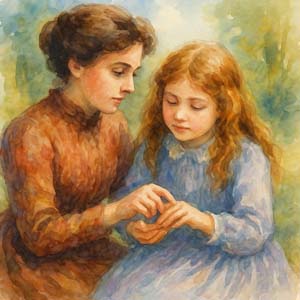— Helen Keller
 A timeless symbol of courage and perseverance, the extraordinary Helen Adams Keller (1880–1968) was born on this day on a farm near Tuscumbia, Alabama. At just 19 months old, an illness—likely scarlet fever—left her without sight or hearing, casting her into a silent, shadowed world.
A timeless symbol of courage and perseverance, the extraordinary Helen Adams Keller (1880–1968) was born on this day on a farm near Tuscumbia, Alabama. At just 19 months old, an illness—likely scarlet fever—left her without sight or hearing, casting her into a silent, shadowed world.
“I was a phantom living in a no-world,” she later wrote in her 1902 autobiography Story of My Life. “My inner life... was a blank without past, present, or future.”
With the help of Alexander Graham Bell, the Kellers hired Anne Mansfield Sullivan (1866–1936) to teach the seven-year-old Helen how to communicate. “The most important day I remember in all my life is the one on which my teacher came to me,” Keller later wrote.
Sullivan was nearly blind herself and with tenacity and spirit forced Helen’s mind from the dark. Hour upon hour, Sullivan signed words into Helen’s hand until the word W-A-T-E-R burst through.
“That living word awakened my soul, gave it light, hope, joy, set it free!” said Keller, who learned to understand others by touching their faces and “reading” as they spoke. Language became her key to overcoming darkness.
“I seldom think about my limitations, and they never make me sad,” Keller said. “Perhaps there is just a touch of yearning at times; but it is vague, like a breeze among flowers.”
With optimism, Helen Keller became a living miracle, graduating cum laude from Radcliffe in 1904. Hailed as “the greatest woman of the 20th century” by Winston Churchill, she went on to inspire the world as a gifted writer and speaker.
An advocate for the dignity of the disabled, she shared her message with grace: “The best and most beautiful things in the world cannot be seen or even touched. They must be felt with the heart.” Her own heart beat with that unseen beauty—offering light, hope, and the courage to dream beyond limits.
 Shine with courage and grace.
Shine with courage and grace.
